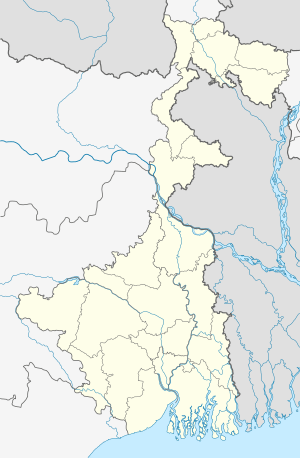Basirhat district
Basirhat district [1] is a proposed border district of West Bengal state. [2] Basirhat subdivision of North 24 Parganas district will be formed separately in Basirhat district. The main river of basirhat district is Ichamati river. The headquarters of this district is Basirhat . There are three municipalities in the district. This Three municipalities are - Basirhat, Baduria and Taki.
Basirhat district | |
|---|---|
Propose district | |
| Nickname(s): Basirhat | |
 Basirhat district Location in West Bengal, India | |
| Coordinates: 22.66°N 88.89°E | |
| Country | |
| State | West Bengal |
| Headquarters | Basirhat |
| Area | |
| • Total | 1,744.57 km2 (673.58 sq mi) |
| Population (2011) | |
| • Total | 20,82,870 |
| • Density | 1,200/km2 (3,100/sq mi) |
| Languages | |
| • Official | Bengali, English |
| Time zone | UTC+5:30 (IST) |
| ISO 3166 code | ISO 3166-2:IN |
Satkhira district of Khulna division in Bangladesh is located on the eastern side of Basirhat district. The Indian commodity exports are imported to Bangladesh by the Ghojdanga land port in this district. The world's famous and largest mangrob forest of Sundarbans is located in the south from the southern part of the country, which flows up to the Bay of Bengal.
History
Basirhat has a long history of farmer's movements like the Tebhaga movement. Freedom fighter Dinesh Chandra Majumder was born here in 1907. Noted industrialist, Sir Rajen Mukherjee[3][4] was born at Bhabla (also spelt Bhyabla) near Basirhat.
Area
Apart from the municipalities of Basirhat, Baduria and Taki, the district contains one census town and rural areas of 90 gram panchayats under ten community development blocks: Baduria, Basirhat–I, Basirhat–II, Haroa, Hasnabad, Hingalganj, Minakhan, Sandeshkhali–I and Sandeshkhali–II and Swarupnagar.[3] The only census town is: Dhanyakuria.[4] Though the area of the district from the administrative level is not clear, perhaps a large part of Bongaon Subdivision will be inserted into the newly created district. According to a proposal that was brought by the government of West Bengal, Basirhat district is supposed to be comprised of two sub-divisions. The two subdivisions were to be headquartered at Basirhat and Minakhan. The Basirhat subdivision would comprise six CD blocks, namely Basirhat–I, Basirhat–II, Hasnabad, Hingalganj, Baduria and Swarupnagar. The Minakhan subdivision would consist of four CD blocks - Minakhan, Sandeshkhali–I, Sandeshkhali–II and Haroa [5]
Geography
Edit Basirhat district is part of the Gangetic delta, lying along the side of the Ichamati River. It is a little raised above flood level and the highest ground borders the river channels. The rivers in the district were formerly distributaries of the Ganges but their mouths have long been filled up and blocked. The area is described as a sort of a drowned land broken by swamps. Land in the north-east of the district is higher than that of the rest of the district. The sturdy peasants raise crops of rice, jute and sugarcane from the alluvial soil. There are clumps of palm and fruit trees in which village homesteads nestle. Industrial activity is concentrated in the narrow strip of land along the Ichamati River. The south-eastern part of the district gradually merges into the Sunderbans.[3]
References
- "5 New district to be formed in West Bengal".
- "Basirhat, Jhargram, Alipurduar, Asansol-durgapur, new district bengal".
- "Directory of District, Sub division, Panchayat Samiti/ Block and Gram Panchayats in West Bengal, March 2008". West Bengal. National Informatics Centre, India. 2008-03-19. Archived from the original on 2009-02-25. Retrieved 2008-12-25.
- "District Wise List of Statutory Towns( Municipal Corporation,Municipality,Notified Area and Cantonment Board) , Census Towns and Outgrowths, West Bengal, 2001". Census of India, Directorate of Census Operations, West Bengal. Archived from the original on 2011-07-21. Retrieved 2008-12-25.
- "5 Basirhat Jhargram Alipurduar & Asansol-Durgapur - New District of Bengal".